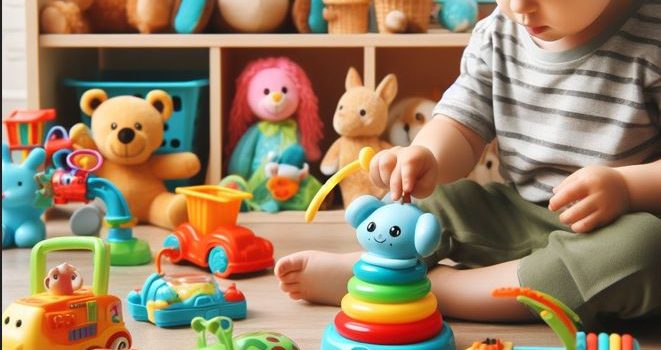
The Ultimate Guide to Choosing the Best Toys for Kids
Understanding the Importance of Toys in Child Development
Toys are far more than mere playthings. They are powerful tools that shape a child’s cognitive, emotional, and social growth. From the moment an infant grasps a rattle to the complex strategies involved in board games during adolescence, toys influence every stage of development. Educational toys, in particular, stimulate curiosity, enhance memory, and foster creativity. They help kids learn fundamental concepts such as numbers, letters, shapes, and colors, often laying the groundwork for future academic success. Moreover, interactive play with toys can boost language skills, encourage problem-solving abilities, and promote fine and gross motor skills.
Toys also serve as a medium through which children explore emotions, relationships, and social norms. Role-playing with dolls or action figures enables them to practice empathy and understand different perspectives. Group play with construction sets or puzzles can teach cooperation, patience, and communication. Therefore, selecting toys that align with developmental milestones is crucial for nurturing well-rounded individuals.
Age-Appropriate Toys: Matching Playthings to Developmental Stages
Every age group experiences unique developmental changes, and toys should be selected accordingly to support these transformations. For infants under 12 months, sensory toys that feature varied textures, gentle sounds, and vibrant colors are ideal. These items encourage visual and auditory recognition, as well as tactile exploration. For toddlers aged one to three, mobility-enhancing toys such as push-and-pull vehicles or soft building blocks are excellent choices. These help in strengthening muscles, refining coordination, and promoting independence.
Preschoolers, typically aged three to five, benefit from toys that support imaginative play. Costumes, puppet sets, and pretend kitchen equipment allow children to mimic real-life scenarios and express themselves creatively. As kids move into early childhood (six to eight years), toys that challenge their reasoning and logic—like science kits, memory games, and math puzzles—can sharpen intellectual capacities. For older children, ages nine and above, strategic board games, advanced construction kits, and arts and crafts projects provide both entertainment and educational value.
The Significance of Safety Standards in Toy Selection
Ensuring a toy’s safety is paramount. Children, especially younger ones, are prone to putting objects in their mouths, making choking hazards a serious concern. All toys should comply with the safety regulations established by recognized institutions such as ASTM International or the Consumer Product Safety Commission (CPSC). These standards assess aspects like material toxicity, durability, flammability, and the size of detachable components.
Parents and caregivers must vigilantly check age recommendations, warning labels, and product reviews before making a purchase. Toys made from non-toxic, BPA-free plastics or natural materials like untreated wood are often safer options. It’s also advisable to avoid toys with sharp edges, small detachable parts, or long cords that could cause strangulation. Regular inspections for wear and tear are essential, especially for frequently used items, to prevent any unexpected accidents.
Balancing Entertainment with Educational Value
While entertainment is a key factor in toy appeal, it’s beneficial when fun is combined with learning. Toys that subtly teach while captivating a child’s interest contribute significantly to skill development. Educational toys come in various forms—interactive electronic devices, language-learning tablets, STEM kits, and musical instruments—all designed to promote different areas of growth.
For example, a talking alphabet poster can improve letter recognition and phonetics. Construction toys like LEGO encourage spatial awareness, problem-solving, and creativity. Math-focused board games enhance numerical fluency in a low-pressure environment. Even simple toys such as shape sorters or abacuses can deliver long-term cognitive benefits. The goal is to choose toys that stimulate a child’s curiosity and foster a lifelong love for learning.
Toys That Encourage Physical Activity and Healthy Habits
Physical play is vital for a child’s health and development. Toys that motivate kids to move, jump, balance, or ride not only improve physical fitness but also enhance coordination and motor control. Ride-on toys, scooters, trampolines, and climbing structures are excellent for building strength and stamina. Balls, hula hoops, and jump ropes support agility and cardiovascular health.
Outdoor play equipment, such as swing sets or mini basketball hoops, encourages group activity, which fosters teamwork and communication. For indoor environments, toys like yoga mats with illustrated poses or dance-based video games can provide active play alternatives. Integrating movement into playtime sets the foundation for a healthy lifestyle and reduces the risk of sedentary behavior-related issues like obesity or poor posture.
Gender-Neutral Toys and the Shift Toward Inclusive Play
The toy industry has increasingly moved toward designing products that defy traditional gender roles. Historically, certain toys were marketed distinctly toward boys or girls, often limiting developmental opportunities and reinforcing stereotypes. Today, there’s a conscious effort to promote gender-neutral toys that focus on interests rather than identity.
Building sets, art supplies, scientific exploration kits, and musical instruments are excellent examples of toys that appeal universally. Such items encourage skills like critical thinking, creativity, and emotional expression regardless of gender. Choosing toys based on a child’s passion and curiosity rather than outdated norms promotes a more inclusive and empowering play environment.
Eco-Friendly Toy Choices: Teaching Responsibility Early
Sustainable toys made from recycled or biodegradable materials are gaining popularity as parents become more environmentally conscious. These eco-friendly alternatives not only reduce ecological footprints but also serve as tools to teach children about sustainability. Brands that prioritize ethical production practices and minimal packaging further reinforce these values.
Wooden toys treated with natural oils, organic cotton plushies, and solar-powered gadgets are examples of responsible choices. Incorporating books and games that teach environmental awareness can also be impactful. When children understand the value of taking care of their planet, they are more likely to adopt eco-conscious habits as they grow.
Interactive and Tech-Driven Toys: Embracing the Digital Age
Technology plays an undeniable role in modern childhood. When used wisely, tech-based toys can offer substantial educational and developmental advantages. Tablets designed specifically for children often feature games and apps that enhance literacy, numeracy, and problem-solving skills. Programmable robots and coding toys introduce kids to computer science in an accessible, engaging format.
Interactive storybooks, smart globes, and augmented reality games combine tactile learning with digital features, creating a multi-sensory experience. However, screen time should be balanced, and content should be age-appropriate and guided by adult supervision. The goal is to harness the potential of technology without compromising interpersonal interaction or physical activity.
Cultural Representation in Toys: Fostering Inclusivity and Awareness
Toys that reflect diverse cultures, ethnicities, and traditions help children develop empathy and global awareness from a young age. Dolls with various skin tones, books that explore international customs, and puzzles featuring world landmarks all contribute to a more inclusive worldview.
Providing children with toys that showcase a range of backgrounds helps normalize diversity and combat bias. Representation in toys also boosts self-esteem in children who see their identity mirrored in their playthings. By embracing cultural inclusivity through toys, caregivers can promote open-mindedness, compassion, and respect for others.
Conclusion: Thoughtful Choices for Lifelong Benefits
Selecting the right toys for children goes far beyond entertainment—it shapes their future. Every rattle, puzzle, building block, and interactive gadget carries the potential to influence how a child thinks, feels, and interacts with the world. Parents and caregivers are entrusted with the responsibility of making thoughtful choices that align with developmental needs, safety standards, personal interests, and evolving values.
By choosing toys that encourage learning, celebrate diversity, promote physical activity, and reflect environmental responsibility, adults create enriching environments where children can thrive. Whether a toy sparks a creative breakthrough, builds social bonds, or lays the foundation for academic growth, its impact can resonate for a lifetime. The ultimate goal is to foster joy, confidence, and curiosity—empowering children to learn, play, and grow with intention.

1 Comment
Hi, this is a comment.
To get started with moderating, editing, and deleting comments, please visit the Comments screen in the dashboard.
Commenter avatars come from Gravatar.